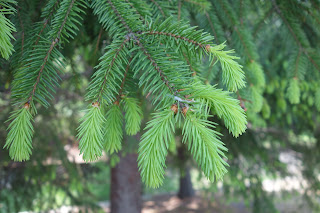On Sunday I ventured to the Daejeon National Cemetery with Jihyeon. There is a subway station near the cemetery (conveniently called National Cemetery Station) and a free shuttle bus from the station to the cemetery every 30 minutes. Just take exit 2 at the subway station and turn left as you exit. You will see a small bus stop.
The cemetery is quite large and there are many places where the bus will drop you off. More info on the bus and where it will drop you off can be found here (sorry, it is in Korean and the English version of the website does not have the same detailed information). Below is a map of the cemetery and the rout the bus will take around the palace. I would suggest getting off the bus at stop 4 or stop 5 as you can sort of do a loop around and see most of the main points of interest.
Between stop 4 and stop 5 there was also a small tent where Buddhists were serving free noodles.
After eating we spent a couple of hours wondering around the cemetery. Pictured here are some families visiting the graves of loved ones. In Korea visiting the graves of people that have passed away is seen as being a really important thing to do. As you can see in the picture below it was a whole family affair. People basically have a picnic by the grave and I am assuming tell stories about the person who passed away or maybe even speak as though the dead person is there with them.
Some graves had small glass boxes filled with pictures of family or personal items of the person that passed away such as knives, rings, war medals and dog tags. Many also had small bottles of Soju (alcohol) or packets of cigarettes.

The graves pictured here are bigger because they were seen as patriots and made important contributions to Korea such as leading the resistance against Japanese occupation.
As we were walking around I randomly pointed to this gave and asked Jihyeon to translate for me. I managed to pick a interesting one. This person was a servant to the second last emperor of Korea, Gojong.
This is a picture of the same persons grave, but capturing the mountain backdrop.
On the 26th of March 2010 the North Koreans sank ROKS Cheonan killing 46 of the 104 personnel on board.
As we walked through the forest I spotted this stone which had a lot of Chinese writing on it. I will ask a Chinese friend of mine to translate it for me, but the person must have been important. Their grave was kind of in its own separate area all by itself.
And as you can see much bigger than all the normal graves.
We took a shortcut through the forest as we headed back towards the cemetery entrance. On the way we saw a snake! It was the first time both I and Jihyeon had seen a snake in Korea. It was gone before I could take a photo of it. It was only about 40cm long and bright green.
I thought this was cool. It is the new growth on the pine trees (a sign of spring).
The new needles (light green coloured) were super soft.
This is the main memorial area where most of the ceremonies are held.
The large urn is filled with some hot coals and is kind of like an eternal fire and sits at the base of the tower pictured above. The smaller urn contains small sticks that you can throw into the larger urn to keep the fire going.
The large urn is decorated with Korean dragons and Korea's national flower (the Mugungwah).
This is the large gateway to the main memorial area. You can see the 3 doors which were used in ancient times. Peasant and servants would use the doors/gateways on the left and right. The middle door/gate was reserved for important people. I walked through the middle gate :).
This photo captures some more statues, the main gate to the memorial area, the memorial tower and Mt Gyeryongsan (a 845m mountain and believed to be the mountain with the most qi in Korea).
There is a collection of old aircraft and other army equipment in the center of the cemetery.
I took this photo out the back window of the bus. Goodbye.


























No comments:
Post a Comment